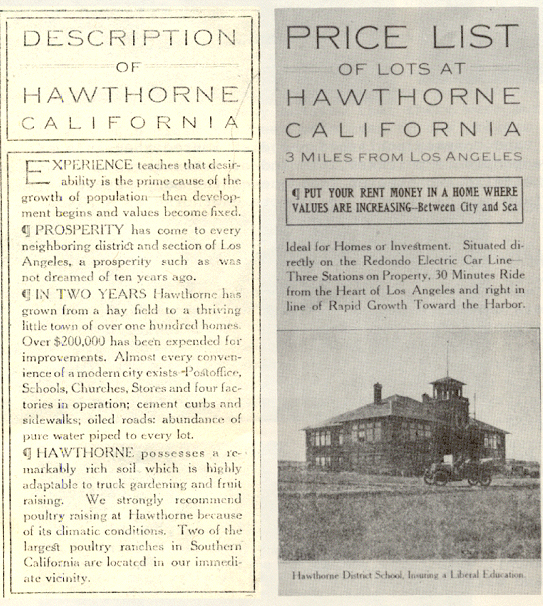The History of Hawthorne by Robert S. Hartman
Residence lots were offered at $200, business lots of $350, orchard plots from $600 to $1,500 depending on size, and acreage at $400 and up. Broadway was plotted as the main street with a circular park, 200 feet radius, in the middle. The Plaza was landscaped in date palms, oleander and acacia trees. The western border of the town, running north and south for 430 yards, was a 20-foot wide dirt path destined to become Hawthorne Boulevard. Today that path is a major highway, one of the widest streets in Southern California, and with a landscaped center strip for parking, is famous as the world's longest parking lot, extending three miles southward from Imperial Boulevard to beyond Rosecrans Avenue.
Many of the Street names originally devised by the company would not now be recognized by Hawthorne citizens. There were no numbered east-west streets. The present Imperial Highway was named Bellview; 116th Street was named Miramar; 118th Street was called Wallace; 119th Street was named Kenwood; 120th Street was called Raymond; 122nd Street was called Euclid; 126th Street was called Lennox; 129th Street was named Main; El Segundo Boulevard was originally named Ballona. The north-south streets of Hawthorne Boulevard, Inglewood Avenue, Menlo, Birch, and Oxford have retained their original names. However Crenshaw was called Cypress; Prairie was named Centennalia, and Grevillea was Sausal.

Sections of a sales pamphlet (1907) distributed by the Hawthorne Land Company.
Prices of lots ranged from $85 to $360, terms 10% cash, balance $5.00 per month.
Recollections | Reunions | Street Scene | Teachers | Tributes | Vietnam | What's New | Keyword Search